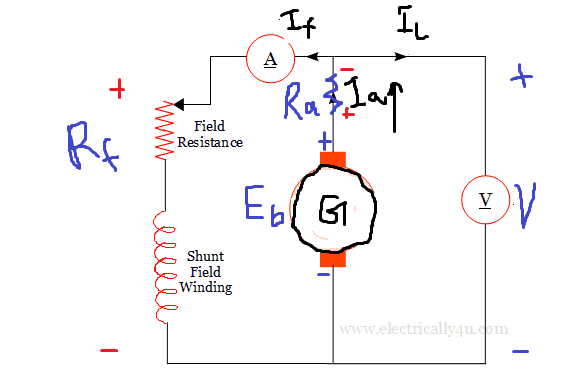A 50 kW de shunt generator delivers an output voltage of 210V at no load when running at 1500 rpm. The generator has an armature resistance of 40 m2, and a field resistance of 158 2 which includes a rheostat for field current control. a) Sketch the electrical circuit of this generator showing all the relevant voltage and currents including direction of currents and voltage polarities. b) If the generator is delivering 18 kW at a terminal voltage of 200V, determine the generator speed and torque. c) While maintaining the terminal voltage at 200V the rheostat was adjusted to increase the field current by 2%. In addition the speed was maintained at the value determined from the previous step (b), what will be the terminal power delivered by the generator under these conditions?
A 50 kW de shunt generator delivers an output voltage of 210V at no load when running at 1500 rpm. The generator has an armature resistance of 40 m2, and a field resistance of 158 2 which includes a rheostat for field current control. a) Sketch the electrical circuit of this generator showing all the relevant voltage and currents including direction of currents and voltage polarities. b) If the generator is delivering 18 kW at a terminal voltage of 200V, determine the generator speed and torque. c) While maintaining the terminal voltage at 200V the rheostat was adjusted to increase the field current by 2%. In addition the speed was maintained at the value determined from the previous step (b), what will be the terminal power delivered by the generator under these conditions?
Introductory Circuit Analysis (13th Edition)
13th Edition
ISBN:9780133923605
Author:Robert L. Boylestad
Publisher:Robert L. Boylestad
Chapter1: Introduction
Section: Chapter Questions
Problem 1P: Visit your local library (at school or home) and describe the extent to which it provides literature...
Related questions
Question
U:51)

Transcribed Image Text:A 50 kW dc shunt generator delivers an output voltage of 210V at no load when running at 1500
rpm. The generator has an armature resistance of 40 m2, and a field resistance of 1582 which
includes a rheostat for field current control.
a) Sketch the electrical circuit of this generator showing all the relevant voltage and currents
including direction of currents and voltage polarities.
b) If the generator is delivering 18 kW at a terminal voltage of 200V, determine the generator
speed and torque.
c) While maintaining the terminal voltage at 200V the rheostat was adjusted to increase the field
current by 2%. In addition the speed was maintained at the value determined from the previous
step (b), what will be the terminal power delivered by the generator under these conditions?
Expert Solution
Step 1
According to question:
a)
The electrical circuit with the direction of current and voltage polarities:

Step 2
b)
From (2) and (3)
Step 3
c)
From (4) and (5)
Step by step
Solved in 5 steps with 1 images

Knowledge Booster
Learn more about
Need a deep-dive on the concept behind this application? Look no further. Learn more about this topic, electrical-engineering and related others by exploring similar questions and additional content below.Recommended textbooks for you

Introductory Circuit Analysis (13th Edition)
Electrical Engineering
ISBN:
9780133923605
Author:
Robert L. Boylestad
Publisher:
PEARSON

Delmar's Standard Textbook Of Electricity
Electrical Engineering
ISBN:
9781337900348
Author:
Stephen L. Herman
Publisher:
Cengage Learning

Programmable Logic Controllers
Electrical Engineering
ISBN:
9780073373843
Author:
Frank D. Petruzella
Publisher:
McGraw-Hill Education

Introductory Circuit Analysis (13th Edition)
Electrical Engineering
ISBN:
9780133923605
Author:
Robert L. Boylestad
Publisher:
PEARSON

Delmar's Standard Textbook Of Electricity
Electrical Engineering
ISBN:
9781337900348
Author:
Stephen L. Herman
Publisher:
Cengage Learning

Programmable Logic Controllers
Electrical Engineering
ISBN:
9780073373843
Author:
Frank D. Petruzella
Publisher:
McGraw-Hill Education

Fundamentals of Electric Circuits
Electrical Engineering
ISBN:
9780078028229
Author:
Charles K Alexander, Matthew Sadiku
Publisher:
McGraw-Hill Education

Electric Circuits. (11th Edition)
Electrical Engineering
ISBN:
9780134746968
Author:
James W. Nilsson, Susan Riedel
Publisher:
PEARSON

Engineering Electromagnetics
Electrical Engineering
ISBN:
9780078028151
Author:
Hayt, William H. (william Hart), Jr, BUCK, John A.
Publisher:
Mcgraw-hill Education,